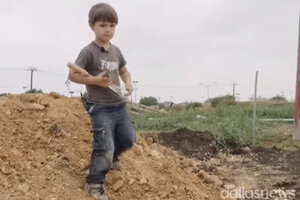Four-year-old discovers 100-million-year-old dinosaur
The discovery of a Late Cretaceous dinosaur puts Wylie Brys in a growing pool of kids who have made notable contributions to science.

If Wylie Brys decides on a career in paleontology, he will have an impressive head start – at just 4 years old, he has already discovered his first 100-million-year-old Cretacean dinosaur.
Wylie came across the fossil in September 2014, while digging for marine animal bones with his father. Researchers from Southern Methodist University, who excavated the remains last week, have tentatively identified the fossil as a heavily-armored nodosaur. The specimen could be more than 100 million years old – but Wylie didn’t know it at the time.
“My dad told me it was a turtle,” Wylie told the Dallas Morning News. “But now he’s telling me it’s a dinosaur.”
Fossil hunting is a favorite pastime of Wylie and his father, Tim Brys, a Dallas zookeeper. But they usually search for the bones of fish and other marine life, not dinosaurs. Texas isn’t exactly a hotbed of fossil discovery, so scientists were surprised to learn that 4-year-old Wylie had dug up the nodosaur behind a grocery store. The bones will be transported to SMU facilities for further studies.
Wylie is the latest in a pool of precocious young scientists who seem unfazed by the age barrier. As the internet makes scientific information increasingly accessible, intellectually curious kids can make significant discoveries without the help of a lab.
In 2011, 10-year-old Kathryn Aurora Gray became the youngest person to discover a supernova. She reported the exploding star, located in the galaxy UGC 3378, under the supervision of her father, astronomer Paul Gray. In a classic case of sibling rivalry, Kathryn's younger brother, Nathan, attempted to set a new record – he discovered his own supernova candidate two years later, just 33 days younger than Kathryn was when she made her discovery.
In August 2014, 10-year-old Noah Cordle found a seemingly unremarkable arrowhead on a New Jersey beach. But the Archeological Society of New Jersey identified the find as a 10,000-year-old native American artifact – native people were still hunting mastodon when it was made. Researchers told Noah that, as the finder, he was the legal owner of the arrowpoint, but he chose to donate the piece to a museum anyway.
These discoveries, even when accidental, provide an opportunity to inspire kids’ curiosity. Fortunately, the traditionally inaccessible scientific community is becoming increasingly welcoming to young people. Programs like the Global STEM Alliance offer mentoring, research projects, and competitions to budding scientists of all ages. A PBS TV program called SciGirls showcases the scientific and engineering feats of middle school girls, in hopes of inspiring others to enter STEM fields (where women are historically underrepresented). These initiatives operate under a relatively new paradigm: As long as fresh minds have larger and better spaces to thrive, age won’t be a barrier to scientific discovery.

